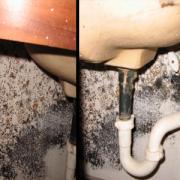
The droppings, body parts, and saliva of cockroaches can be asthma triggers. Cockroaches are commonly found in crowded cities and in the southern United States. Allergens contained in the feces and saliva of cockroaches can cause allergic reactions or trigger asthma symptoms. A national study by Crain et al. of 994 inner-city allergic children from seven U.S. cities revealed that cockroaches were reported in 58% of the homes. Special attention to cleaning must be a priority after eliminating the presence of cockroaches to get rid of the presence of any allergens left that can be asthma triggers.

Another group of indoor pollutants linked to asthma is house dust mites. Studies have revealed that humid homes have more mites and, subsequently, more allergens and fecal pellets deposited by the mites accumulate in home fabrics, which could become airborne via domestic activities such as vacuuming and dusting, resulting in inhalation by those who live in the home. Mites prefer relative humidity levels of 70% to 80% and temperatures of 75°F to 80°F (24°C to 27°C). Most mites are found in bedrooms in bedding. A typical used mattress may have from 100,000 to 10 million mites in it. In addition, carpeted floors, especially long, loose pile carpet, provide a habitat for the accumulation of food and moisture for the mite, and also provide protection from removal by vacuuming. The house dust mite’s favorite food is human dander (skin flakes), which are shed frequently.
Take these precautions if you have asthma:
- Use synthetic rather than feather and down pillows.
- Use an approved allergen barrier cover to enclose the top and sides of mattresses and pillows and the base of the bed
- Use a damp cloth to dust the plastic mattress cover daily.
- Change bedding and vacuum the bed base and mattress weekly.
- Use nylon or cotton cellulose blankets rather than wool blankets.
- Use hot (120°F–130°F [49°C–54°C]) water to wash all bedding, as well as room curtains.
- Eliminate or reduce fabric wall hangings, curtains, and drapes.
- Use wood, tile, linoleum, or vinyl floor covering rather than carpet. If carpet is present, vacuum regularly with a high-efficiency particulate air (HEPA) vacuum or a household vacuum with a microfiltration bag.
- Purchase stuffed toys that are machine washable.
- Use fitted sheets to help reduce the accumulation of human skin on the mattress surface.
- Reduce indoor humidity to below 50% and installing central air conditioning.

The common bed bug (Cimex lectularius) has long been a pest – feeding on blood, causing itchy bites and generally irritating their human hosts. The Environmental Protection Agency (EPA), the Centers for Disease Control and Prevention (CDC), and the United States Department of Agriculture (USDA) all consider bed bugs a public health pest. However, unlike most public health pests, bed bugs are not known to transmit or spread disease.
The good news is that there are ways to control bed bugs. Getting good, solid information is the first step in both prevention and control. While there is no chemical quick fix, there are effective strategies to control bed bugs involving both non-chemical and chemical methods.
Bed bugs can be hard to find and identify, given their small size and their habit of staying hidden. It helps to know what they look like, since the various life stages have different forms.
More information:
http://www.michigan.gov/emergingdiseases/0,1607,7-186-26346_25949_55522---,00.html
http://www.michigan.gov/documents/emergingdiseases/Bed_Bug_Manual_v1_full_reduce_326605_7.pdf

According to the U.S. Environmental Protection Agency (EPA), pets can be significant asthma triggers because of dead skin flakes, urine, feces, saliva, and hair. Proteins in the dander, urine, or saliva of warm-blooded animals can sensitize individuals and lead to allergic reactions or trigger asthmatic episodes. Warm-blooded animals include dogs, cats, birds, and rodents (hamsters, guinea pigs, gerbils, rats, and mice). Numerous strategies, such as the following, can diminish or eliminate animal allergens in the home:
Eliminate animals from the home. Thoroughly clean the home (including floors and walls) after animal removal.
If pets must remain in the home, reduce pet exposure in sleeping areas. Keep pets away from upholstered furniture, carpeted areas, and stuffed toys, and keep the pets outdoors as much as possible.

Molds are microscopic fungi that live on plant or animal matter. They serve an important, positive role by helping to decompose organic matter. It is estimated that there are more than 100,000 species of mold. At least 1,000 species are common in the U.S.
Where are molds found?
Molds are found in virtually every environment and can be detected year round both indoors and outdoors. Mold growth is encouraged by warm and humid conditions. They can be found outdoors in shady, damp areas or places of decomposing vegetation. Indoors, mold can be found where there is sufficient moisture or where humidity levels are high, such as basements or showers.
What are the potential health effects of mold?
The most common types of mold are generally not hazardous to healthy individuals. People who have asthma, hay fever or other allergies or who have weakened immune systems are more likely to react to mold. Common symptoms include runny nose, eye irritations, skin rash, cough, congestion and aggravation of asthma or allergies. These symptoms should stop when mold level is reduced.
How do you know if you have a mold problem? Should the house be tested for mold?
Trained professionals can test for mold. However, these tests can be expensive and are usually considered unnecessary. Testing results will always be positive, since mold occurs everywhere. Additionally, there are no standards for safe or unsafe levels of mold. Whenever you see or smell mold, assume there is a problem and take measures to reduce the presence of mold in your home or building.
Large mold infestations can usually be seen or smelled.
What Is Stachybotrys chartarum (pronounced Stack-ee-BOT-ris; also known as Stachybotrys atra)?
This is the "black mold" that you hear and read about. Stachybotrys chartarum (SC) is one mold that is associated with health effects in people. SC is a greenish-black mold that can grow on materials with a high cellulose content (drywall, dropped ceiling tiles, wood) that are chronically moist or water damaged as a result of high humidity, water leaks, condensation or flooding. SC is a relatively uncommon mold. SC spores do not become easily airborne and therefore contamination of indoor air by SC is unusual.
How can you tell if Stachybotrys chartarum is present in your home?
Many molds are black in appearance but are not Stachybotrys chartarum. For example, the black mold commonly found between bathroom tiles is not SC. Stachybotrys chartarum can only be positively identified through microscopic examination or by specially trained professionals.
What should you do if you have mold in your home?
Indoor mold growth indicates a problem with water or moisture. You should not need to take any different precautions with Stachybotrys chartarum than with other molds.
Nonporous (e.g., metals, glass, and hard plastics) and semiporous (e.g., wood and concrete) materials contaminated with mold that are still structurally sound can often be cleaned with bleach-and-water solutions (1-2 c. bleach/gallon of water).
It is recommended that porous materials (e.g., ceiling tiles, wallboards, carpeting and fabrics) that cannot be cleaned be removed and discarded. In rare cases with extensive mold growth (large surface areas greater than 100 square feet or where the material is severely degraded), clean-up may require extreme precautions.
How can you keep mold out of your home?
There is no practical way to eliminate all molds and mold spores in the indoor environment; the way to control indoor mold growth is to control moisture.
Common intervention methods for addressing mold problems include the following:
- fixing water leakage problems
- increasing ventilation in kitchens and bathrooms by using exhaust fans
- maintaining heating, ventilating, and air conditioning (HVAC) systems
- changing HVAC filters frequently, as recommended by manufacturer
- keeping gutters and downspouts in working order and ensuring that they drain water away from the foundation
- routinely checking, cleaning, and drying drip pans in air conditioners, refrigerators, and dehumidifiers
- increasing ventilation (e.g., using exhaust fans or open windows to remove humidity when cooking, showering, or using the dishwasher)
- venting clothes dryers to the outside
- maintaining an ideal relative humidity level in the home of 40% to 60% by using a dehumidifier
- locating and removing sources of moisture (controlling dampness and humidity and repairing water leakage problems)
- cleaning or removing mold-contaminated materials
- sloping surrounding soil away from building foundations
- heating all rooms in the winter and adding heating to outside wall closets
- reducing the number of indoor plants
- using air conditioning at times of high outdoor humidity
- removing materials with severe mold growth
- using high-efficiency air filters.
- using a sump pump in basements prone to flooding
- vapor barriers, sump pumps, and aboveground vents can also be installed in crawlspaces to prevent moisture problems.
- Clean and dry damp/wet building materials and furnishings within 24 - 48 hours to prevent mold growth.
- Prevent condensation: Reduce the potential for condensation on cold surfaces (windows, piping, exterior walls, roof or floors) by adding insulation.
- In areas where there is a perpetual moisture problem, do not install carpeting
Other Resources






